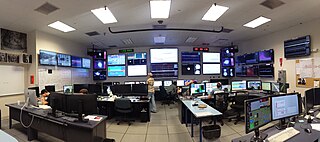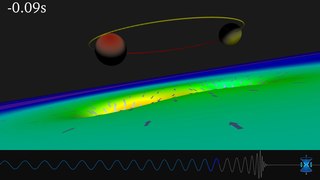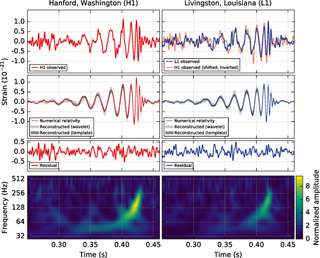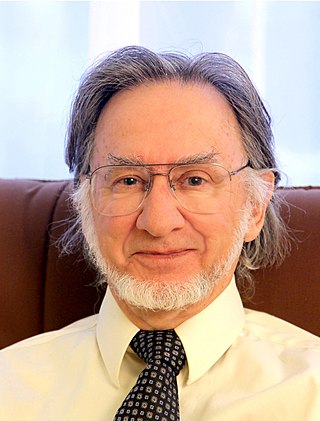
The Laser Interferometer Gravitational-Wave Observatory (LIGO) is a large-scale physics experiment and observatory designed to detect cosmic gravitational waves and to develop gravitational-wave observations as an astronomical tool. Two large observatories were built in the United States with the aim of detecting gravitational waves by laser interferometry. These observatories use mirrors spaced four kilometers apart which are capable of detecting a change of less than one ten-thousandth the charge diameter of a proton.

Rainer "Rai" Weiss is a German-born American physicist, known for his contributions in gravitational physics and astrophysics. He is a professor of physics emeritus at MIT and an adjunct professor at LSU. He is best known for inventing the laser interferometric technique which is the basic operation of LIGO. He was Chair of the COBE Science Working Group.

The Laser Interferometer Space Antenna (LISA) is a proposed space probe to detect and accurately measure gravitational waves—tiny ripples in the fabric of spacetime—from astronomical sources. LISA would be the first dedicated space-based gravitational-wave observatory. It aims to measure gravitational waves directly by using laser interferometry. The LISA concept has a constellation of three spacecraft arranged in an equilateral triangle with sides 2.5 million kilometres long, flying along an Earth-like heliocentric orbit. The distance between the satellites is precisely monitored to detect a passing gravitational wave.

GEO600 is a gravitational wave detector located near Sarstedt, a town 20 km to the south of Hanover, Germany. It is designed and operated by scientists from the Max Planck Institute for Gravitational Physics, Max Planck Institute of Quantum Optics and the Leibniz Universität Hannover, along with University of Glasgow, University of Birmingham and Cardiff University in the United Kingdom, and is funded by the Max Planck Society and the Science and Technology Facilities Council (STFC). GEO600 is capable of detecting gravitational waves in the frequency range 50 Hz to 1.5 kHz, and is part of a worldwide network of gravitational wave detectors. This instrument, and its sister interferometric detectors, when operational, are some of the most sensitive gravitational wave detectors ever designed. They are designed to detect relative changes in distance of the order of 10−21, about the size of a single atom compared to the distance from the Sun to the Earth. Construction on the project began in 1995.
The gravitational wave background is a random background of gravitational waves permeating the Universe, which is detectable by gravitational-wave experiments, like pulsar timing arrays. The signal may be intrinsically random, like from stochastic processes in the early Universe, or may be produced by an incoherent superposition of a large number of weak independent unresolved gravitational-wave sources, like supermassive black-hole binaries. Detecting the gravitational wave background can provide information that is inaccessible by any other means, about astrophysical source population, like hypothetical ancient supermassive black-hole binaries, and early Universe processes, like hypothetical primordial inflation and cosmic strings.
A Weber bar is a device used in the detection of gravitational waves first devised and constructed by physicist Joseph Weber at the University of Maryland. The device consisted of aluminium cylinders, 2 meters in length and 1 meter in diameter, antennae for detecting gravitational waves.

The Virgo interferometer is a large Michelson interferometer designed to detect gravitational waves predicted by general relativity. It is located in Santo Stefano a Macerata, near the city of Pisa, Italy. The instrument's two arms are three kilometres long, housing its mirrors and instrumentation inside an ultra-high vacuum.

Gravitational waves are waves of the intensity of gravity that are generated by the accelerated masses of binary stars and other motions of gravitating masses, and propagate as waves outward from their source at the speed of light. They were first proposed by Oliver Heaviside in 1893 and then later by Henri Poincaré in 1905 as the gravitational equivalent of electromagnetic waves.

A gravitational-wave detector is any device designed to measure tiny distortions of spacetime called gravitational waves. Since the 1960s, various kinds of gravitational-wave detectors have been built and constantly improved. The present-day generation of laser interferometers has reached the necessary sensitivity to detect gravitational waves from astronomical sources, thus forming the primary tool of gravitational-wave astronomy.

Gravitational-wave astronomy is an emerging field of science, concerning the observations of gravitational waves to collect relatively unique data and make inferences about objects such as neutron stars and black holes, events such as supernovae, and processes including those of the early universe shortly after the Big Bang.
David Howard Reitze is an American laser physicist who is professor of physics at the University of Florida and served as the scientific spokesman of the Laser Interferometer Gravitational-Wave Observatory (LIGO) experiment in 2007-2011. In August 2011, he took a leave of absence from the University of Florida to be the Executive Director of LIGO, stationed at the California Institute of Technology, Pasadena, California. He obtained his BA in 1983 from Northwestern University, his PhD in physics from the University of Texas at Austin in 1990, and had positions at Bell Communications Research and Lawrence Livermore National Laboratory, before taking his faculty position at the University of Florida. He is a Fellow of the American Physical Society, the Optical Society, and the American Association for the Advancement of Science.

A coherent perfect absorber (CPA), or anti-laser, is a device which absorbs coherent light and converts it to some form of internal energy such as heat or electrical energy. It is the time-reversed counterpart of a laser. The concept was first published in the July 26, 2010, issue of Physical Review Letters, by a team at Yale University led by theorist A. Douglas Stone and experimental physicist Hui W. Cao. In the September 9, 2010, issue of Physical Review A, Stefano Longhi of Polytechnic University of Milan showed how to combine a laser and an anti-laser in a single device. In February 2011 the team at Yale built the first working anti-laser. It is a two-channel CPA device which absorbs the output of two lasers, but only when the beams have the correct phases and amplitudes. The initial device absorbed 99.4 percent of all incoming light, but the team behind the invention believe it will be possible to achieve 99.999 percent. Originally with the FP cavity, the optical CPA operates to a specific frequency and the wavelength-thick material. In January 2012, thin-film CPA has been proposed by utilizing the achromatic dispersion of metal, exhibiting the unparalleled bandwidth and thin profile advantages. This theoretical evaluation was experimentally demonstrated in 2014.
Allegro was a ground-based, cryogenic resonant Weber bar, gravitational-wave detector run by Warren Johnson, et al. at Louisiana State University in Baton Rouge, Louisiana. The detector was commissioned in the early 1990s, and was decommissioned in 2008.
The DECi-hertz Interferometer Gravitational wave Observatory is a proposed Japanese, space-based, gravitational wave observatory. The laser interferometric gravitational wave detector is so named because it is designed to be most sensitive in the frequency band between 0.1 and 10 Hz, filling in the gap between the sensitive bands of LIGO and LISA. Its precursor mission, B-DECIGO, is currently planned for launch in the 2030s, with DECIGO launching at some time afterward.

The first direct observation of gravitational waves was made on 14 September 2015 and was announced by the LIGO and Virgo collaborations on 11 February 2016. Previously, gravitational waves had been inferred only indirectly, via their effect on the timing of pulsars in binary star systems. The waveform, detected by both LIGO observatories, matched the predictions of general relativity for a gravitational wave emanating from the inward spiral and merger of a pair of black holes of around 36 and 29 solar masses and the subsequent "ringdown" of the single resulting black hole. The signal was named GW150914. It was also the first observation of a binary black hole merger, demonstrating both the existence of binary stellar-mass black hole systems and the fact that such mergers could occur within the current age of the universe.
David Ernest McClelland is an Australian physicist, with his research focused on the development of the manipulation and control of optical quantum states, and its implementation into gravitational wave observatories. He is a Fellow of the Australian Academy of Science, the American Physical Society and the Optical Society of America. Since 2001, he has been a professor at the Australian National University (ANU) in the Research School of Physics and Engineering, in Canberra (Australia). He is Director of the ANU's Centre for Gravitational Astrophysics and Deputy Director of OzGrav - the Australian Research Council Centre of Excellence in Gravitational Wave Discovery.
Levitation based inertial sensing is a new and rapidly growing technique for measuring linear acceleration, rotation and orientation of a body. Based on this technique, inertial sensors such as accelerometers and gyroscopes, enables ultra-sensitive inertial sensing. For example, the world's best accelerometer used in the LISA Pathfinder in-flight experiment is based on a levitation system which reaches a sensitivity of and noise of .

Jean-Paul Richard was a Canadian physicist, academic and researcher. He was a Professor of Physics at the University of Maryland.

Stefano Vitale is an Italian physicist and a retired professor of experimental physics at the University of Trento. He is known for his scientific contributions in the field of gravitational wave (GW) research and the successful management of international scientific projects.
Jens Horst Gundlach is a German physicist.











